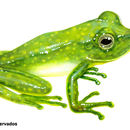Description
(
anglais
)
fourni par AmphibiaWeb articles
Males reach 24-26 mm SVL, females 25-27 mm SVL (Kubicki 2006). This species is canary-yellow with green reticulations, giving the appearance of yellow spots (smaller on the head and neck) on a green background (Kubicki 2006). It can be distinguished by having a green mid-dorsal line but no yellow paravertebral stripes (Kubicki 2006), a rounded snout in profile with protruding nostril swellings (Savage 2002), an indistinct tympanum (Savage 2002), and a visible red heart (Kubicki 2006).The head is broad with a snout that is rounded in profile and weakly pointed in dorsal view, protuberant nostrils, and a tympanum that is indistinct (Savage 2002). The pupil is elliptical (Kubicki 2006). Finger I is longer than finger II and fingers have truncated discs (Savage 2002). Webbing is vestigial between finger I and II but varies between specimens as to the other fingers, with extensive webbing between Fingers III-V in some specimens (Kubicki 2006). Toes are rounded, with extensive webbing (Savage 2002). Males do not have nuptial pads (Savage 2002). The inner metatarsal tubercle is small, round, and flattened, while the outer metatarsal tubercle and tarsal fold are lacking (Savage 2002). Bones are yellowish white (Kubicki 2006). It has a colorless pericardial sac, leaving the red heart visible, but the liver and other digestive organs have a white visceral covering (Kubicki 2006). The skin surface is shagreened dorsally and is green with moderate-size yellow spots (Savage 2002). The venter is transparent, while the ventral surfaces of limbs are flesh-colored (Savage 2002). The iris is gold with small black dots (Kubicki 2006).Hyalinobatrachium talamancae is similar to H. fleischmanii but can be distinguished by the rounded snout in profile (vs. truncated in H. fleischmanii), protuberant nares (vs. no narial swellings in H. fleishmanii), and an indistinct tympanum (vs. a hidden tympanum in H. fleishmanii) (Savage 2002). It is also similar to H. vireovittatum but differs from that species by lacking paired yellow paravertebral stripes (vs. yellow paravertebral stripes present on either side of the green mid-dorsal line in H. vireovittatum) (Kubicki 2006).A Spanish-language species account can be found at the website of Instituto Nacional de Biodiversidad (INBio) (http://darnis.inbio.ac.cr/FMPro?-DB=UBIpub.fp3&-lay=WebAll&-Format=/ubi/detail.html&-Op=bw&id=4390&-Find).
- Kubicki, B. (2006). ''Rediscovery of the Green-striped Glass Frog Hyalinobatrachium talamancae (Anura: Centrolenidae) in Costa Rica .'' Brenesia , 66, 25-30.
- Kubicki, B., Bolaños, F., Chaves, G., Solís, F., and Ibáñez, R. (2004). Hyalinobatrachium talamancae. In: IUCN 2009. IUCN Red List of Threatened Species. Version 2009.1. www.iucnredlist.org. Downloaded on 28 July 2009.
- Taylor, E.H. (1952). "A review of the frogs and toads of Costa Rica." University of Kansas Science Bulletin, 35, 577-942.
Distribution and Habitat
(
anglais
)
fourni par AmphibiaWeb articles
The type locality is Moravia de Chirripó, Cartago Province, Costa Rica at 1,116 meters a.s.l. (Taylor 1952). However, repeated searches have failed to find additional specimens at the type locality, as the locality has been converted to cattle farming (Kubicki 2006). Other localities include Fila Asunción, Limón Province at 475 meters a.s.l.; Quebrada Talamancae, Limón Province, at 515 meters a.s.l.; the foothills above the town of Alegría on the Atlantic side of the Turrialba Volcano at 850 meters a.s.l.; and Quebrada Ilex, Limón Province, at 500 meters a.s.l. (Kubicki 2006). All sites have been classified as Tropical Premontane Rain Forest, excluding Fila Asunción, Limón Province, which is Tropical Wet Forest (Holdridge 1967). All sites have high to medium-gradient streams surrounded by an abundance of smooth-leaved plants (Kubicki 2006).
Life History, Abundance, Activity, and Special Behaviors
(
anglais
)
fourni par AmphibiaWeb articles
Breeding takes place along seepages as well as smaller to medium-sized high gradient streams. The call is a long, low whistle with no obvious rise in pitch at the end, lasting approximately 0.3 seconds. The initial frequency is 4.3 kHz, rising to 4.9 kHz and then falling to 4.6 kHz. Males typically call from the undersides (but sometimes the upper surfaces) of smooth leaves overhanging 2-5 meters above streams, as often as every 10 seconds. Amplexus has been observed to take place usually within the first few hours of darkness. Males are commonly seen at night (and sometimes during the day) guarding a clutch of 20-30 eggs, which are amassed towards the center undersides of leaves. The clutch is laid in a single layer surrounded by a clear jelly substance. Eggs are initially a greenish-white and then change to pinkish-tan as they develop. They hatch after 15 days and larvae then fall into the stream to continue development (Kubicki 2006).
Life History, Abundance, Activity, and Special Behaviors
(
anglais
)
fourni par AmphibiaWeb articles
This species is stable in numbers and is present in many protected areas, although the type locality has been turned into cattle farms (Kubicki et al. 2004).
Hyalinobatrachium talamancae
(
anglais
)
fourni par wikipedia EN
- licence
- cc-by-sa-3.0
- droit d’auteur
- Wikipedia authors and editors
Hyalinobatrachium talamancae: Brief Summary
(
anglais
)
fourni par wikipedia EN
Hyalinobatrachium talamancae is a species of frog in the family Centrolenidae. It is endemic to the Limón Province, Costa Rica. Its common name is Talamanca glass frog. Its natural habitats are premontane wet forests. It is a regularly seen frog in suitable habitat.
- licence
- cc-by-sa-3.0
- droit d’auteur
- Wikipedia authors and editors

